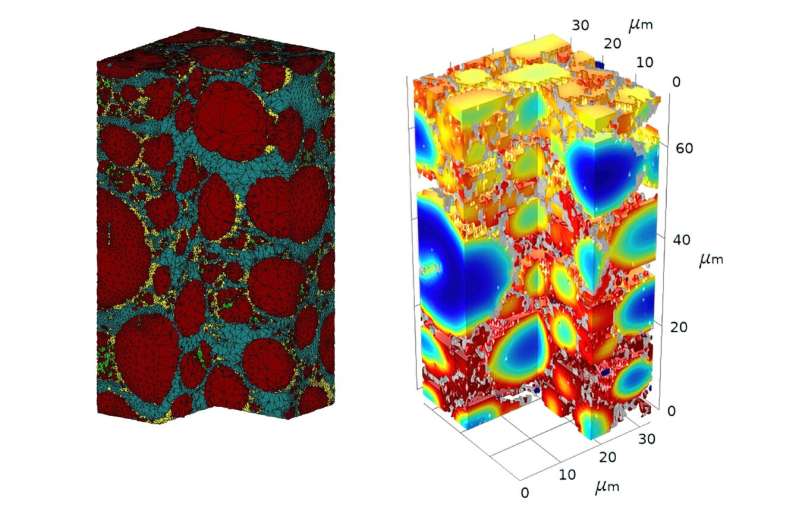
From the moment you first use it, a new lithium-ion battery is degrading. After a few hundred charge cycles, you’ll notice—your phone, laptop or electric car battery wears out more quickly. Eventually, it stops holding a charge at all.
Researchers at the University of Chicago’s Pritzker School of Molecular Engineering (PME) have now used a combination of high-powered electron microscopy and computational modeling to understand, at an atomic level, exactly what occurs when lithium-ion batteries degrade. Their research points toward one approach to designing longer-lasting lithium-ion batteries—by focusing on an oft-ignored structural component, the carbon binder domain (CBD).
“To tackle many of the world’s energy storage and conversion challenges over coming decades, we need to keep innovating and improving batteries,” said Prof. Y. Shirley Meng, who led the research, published in the journal Joule. “This work is one step toward more efficient and sustainable battery technology.”
Limited charge cycles
The widespread commercialization of lithium-ion batteries at the end of the twentieth century played a role in the advent of lightweight, rechargeable electronics. Lithium is the lightest metal and has a high energy density-to-weight ratio. When a lithium-ion battery is charged, lithium ions move from a positively charged cathode to a negatively charged anode. To release energy, those ions flow back from the anode to the cathode.
Throughout charging cycles, the active materials of the cathode and anode expand and contract, accumulating “particle cracks” and other physical damage. Over time, this makes lithium-ion batteries work less well.
Researchers have previously characterized the particle cracking and degradation that occurs in small, thin electrodes for lithium-ion batteries. However, thicker, more energy-dense electrodes are now being developed for larger batteries—with applications such as electric cars, trucks and airplanes.
“The kinetics of a thick electrode are quite different from those of a thin electrode,” said project scientist Minghao Zhang of the University of California San Diego, a co-first author of the new paper. “Degradation is actually much worse in thicker, higher-energy electrodes, which has been a struggle for the field.”
It’s also harder to quantitatively study thick electrodes, Zhang pointed out. The tools that previously worked to study thin electrodes can’t capture the structures of larger, denser materials.
Combining microscopy and modeling
In the new work, Meng, Zhang and collaborators from Thermo Fisher Scientific turned to Plasma focused ion beam-scanning electron microscopy (PFIB-SEM) to visualize the changes that occur inside a thick lithium-ion battery cathode. PFIB-SEM uses focused rays charged ions and electrons to assemble an ultra-high-resolution picture of a material’s three-dimensional structure.
The researchers used the imaging approach to collect data on a brand new cathode as well as one that had been charged and depleted 15 times. With the data from the electron microscopy experiments, the team built computational models illustrating the process of degradation in the batteries.
“This combination of nanoscale resolution experimental data and modeling is what allowed us to determine how the cathode degrades,” said PME postdoctoral research fellow Mehdi Chouchane, a co-first author of the paper. “Without the modeling, it would have been very hard to prove what was happening.”
The researchers discovered that variation between areas of the battery encouraged many of the structural changes. Electrolyte corrosion occurred more frequently with a thin layer at the surface of the cathode. This top layer therefore developed a thicker resistive layer, which led the bottom layer to expand and contract more than other parts of the cathode, leading to faster degradation.
The model also pointed toward the importance of CBD—a porous grid of fluoropolymer and carbon atoms that holds the active materials of an electrode together contribute and helps conduct electricity through the battery. Previous research has not characterized how the CBD degrades during battery use, but the new work suggested that the weakening of contacts between the CBD and active materials of the cathode directly to the decline in performance of lithium-ion batteries over time.
“This change was even more obvious than the cracking of the active material, which is what many researchers have focused on in the past,” said Zhang.
Batteries of the future
With their model of the cathode, Meng’s group studied how tweaks to the electrode design might impact its degradation. They showed that changing the CBD structure network could help prevent the worsening of contacts between the CBD and active materials, making batteries last longer—a hypothesis that engineers can now follow up with physical experiments.
The group is now using the same approach to study even thicker cathodes, as well as carrying out additional modeling on how to slow electrode degradation.
Said Dr. Zhao Liu, senior manager for battery market development at Thermo Fisher Scientific, who contributed to the research, “This study develops a methodology of how to design electrodes to enhance future battery performance.”